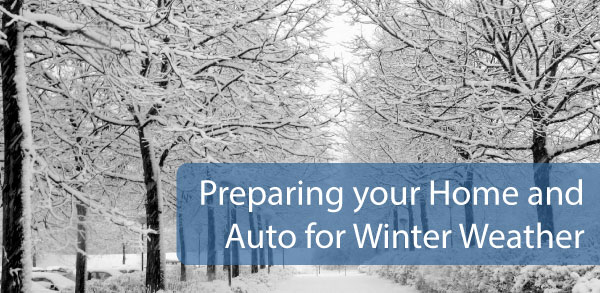If you live in area where it snows you know the drill. Three to four months of heavy clothes, seeing your breath and generally freezing outside. But beyond the inconvenience and discomfort, a winter storm or other severe weather conditions can cause real damage. So it’s important to think about winter preparedness.
Protecting your home is vital. A frozen water pipe can burst and flood your house or basement. An ice dam in your gutter can cause water to seep into and saturate an interior wall. And then there’s your car. Making sure it’s prepped to face winter’s worst is just as critical. After all, what would happen if a blizzard stranded you in your car? Below you will find tips for preparing your home and auto for the upcoming winter months.
Curious on how your homeowners and auto insurance will respond to winter risks? Please give our office a call and we’ll be happy to answer your questions.
Prepare yourself
Some winter weather tips to help you get through a severe stretch of cold:
- Stay indoors during the storm.
- Walk carefully on snowy, icy walkways.
- Avoid overexertion when shoveling snow. It’s a serious workout, and going at it too hard can bring on a heart attack − a major cause of death in the winter. If you must shovel snow, stretch before going outside.
- Stay dry. Wet clothing loses all of its insulating value and transmits the cold rapidly.
Cold-related injuries
- Watch for signs of frostbite: loss of feeling and white or pale appearance in extremities. If any of these occur, get medical help immediately.
- Watch for signs of hypothermia: uncontrollable shivering, memory loss, disorientation, incoherence, slurred speech, drowsiness and apparent exhaustion.
- If any of the hypothermia symptoms appear, get yourself (or the victim) to a warm location, remove wet clothing, and warm the center of the body first. Give the patient warm, non-alcoholic beverages if they are conscious. And of course, get medical help as soon as possible.
Prepare your home
Some tips to brace your home for a winter storm:
- Clean out the gutters, disconnect and drain all outside hoses. If possible, shut off outside water valves.
- Insulate walls and attics, and caulk and weather-strip doors and windows.
- Repair roof leaks and remove tree branches that could get weighed down with ice or snow and fall on your house – or your neighbor’s. (Avoid liability for the latter.)
- Wrap water pipes in your basement or crawl spaces with insulation sleeves to slow heat transfer.
- Consider an insulated blanket for your hot water heater.
- If you have a fireplace, keep the flue closed when you’re not using it.
- Have a contractor check your roof to see if it would sustain the weight of a heavy snowfall.
- Make sure your furniture isn’t blocking your home’s heating vents.
- During cold spells, keep cabinet doors open to allow warm air to circulate around pipes, particularly those in the kitchen and bathrooms.
- Keep a slow trickle of water flowing through faucets connected to pipes that run through unheated or unprotected spaces.
- If your house will be unattended during cold periods, consider draining the water system.
- Avoid ice dams – where water from melted snow refreezes in the gutters and seeps in under the roof, soaking interior walls.
Prepare your car
According to the Department of Transportation, 22% of all vehicle crashes in the U.S. – and 16% of the fatalities – are due to severe weather such as rain, snow, sleet and ice. So, prepare your car for treacherous conditions and extremely cold temperatures – and know what to do if you find yourself stranded in a vehicle. When the temperatures start to drop:
- Drive only if it is absolutely necessary. If you must drive, travel during the day.
- Don’t travel alone. Keep others informed of your schedule.
- Stay on main roads and avoid back road shortcuts.
- Top off antifreeze, windshield wiper fluid, gas, oil and other fluids.
- Make sure your tires have enough tread. Consider snow tires.
- Keep bagged salt or sand in the trunk for extra traction and to melt ice.
- Clear snow from the top of the car, headlights and windows.
- Save the numbers for your auto club, insurance agent and towing service into your cell phone.
- Keep a cold-weather kit in your trunk. It should include a blanket or sleeping bag, gloves, hard candy, bottled water, folding shovel, first aid kit, flashlight and cell phone charger.
If you’re trapped in a vehicle
- Remain inside. Rescuers are more likely to find you there.
- Run the engine and heater about 10 minutes every hour. Clear any snow from the exhaust pipe to reduce your risk of carbon monoxide poisoning.
- Move around to maintain heat.
- Use maps, floor mats and seat covers for insulation.
- Take turns sleeping. Someone should always be awake to alert rescuers.
- Drink fluids to avoid dehydration.
- Turn on the inside light at night so rescue crews can find you.
- If you’re stranded in a remote area, stomp out the words “SOS” or “HELP” in the snow.



